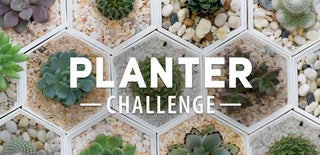Introduction: Flower Box With Hydroculture
First I want to tell you something about me:
My name is Daniel and I am a German blogger. The main topic of the blog is all about electronics. This was my first non-electronic project and I like it very much. If you want to see more projects, please visit my German website elektronik-sammlung.jimdo.com or follow @ESammlung on twitter.
So let's start working!
Step 1: Introduction
List of material:
-11 Spruce-batten unplaned 24x48x2000mm
- 2 Spruce-batten unplaned 17x36x2000mm
- 1 MDF plate for the ground (you can also use a thicker plywood or OSB)
- 4 Bags of expanded clay 30L
- 1 Water level indicator 28cm
- 1 Pond foil (or another foil)
- 1 Tube of silicone (color doesn't matter)
- 1 bottle of wood paint (I used Auro wood-glaze white)
- 4 PVC steering caster
- and of course plants you like
Costs:
This project is relatively expensive. Especially the expanded clay costs with its 64€ (~$75) very much. To reduce costs you can also use normal potting soil. If you want to do this, you'll save 64€ for the expanded clay and 8€ (~$9.50) for the water level indicator. But because of its huge size I prefer the hydroculture with the expensive expanded clay. The whole project will cost atleast 120€ (~$146).
Step 2: Preparing the Wood
First we have to cut the Spruce-batten to the correct lenght. By using a mitre saw you will reach the fastest and the most precise result. But don't forget cut cut the ends first, because they are often cut incorrectly and/or they are very rough. Then we have to cut the 24x48mm batten into the right lenght. We need 8pcs with a lenght of 50 and 90.5cm as well as 6 pcs with a lenght of 46 and 94.5cm. The MDF-plate has to be cut to 46x90.5cm. We also need 2pcs of the 17x36mm batten with a lenght od 42.5 an 90.5cm in each case.
To reduce costs, I used freshly sawn lumber. If you want to use planed wood, you can jump to step 2. Now we have to plane all battens. Please be carefull that all battens have the same thickness after planing them. You should also plane the edges in a 45° angle, because it's very important for the later look.
The finished battens you can see in the picture above.
Step 3: Screwing Everything Together
After preparing every part corrctly, we have to screw them together. First we have to build a frame out of the 50 an 90.5cm long battens. On this frame we build a second frame with the 46 an 94.5cm long battens and screw them together. This process has to be repeated until no battens are left. Then we have to screw the smaller battens into the box. The MDF-plate has to be fixed on the smaller battens. Please notice that the PVC steering casters have to fit under the plate, but we dont want to see them later.
Step 4: Here Is the Paint!
Before painting the box, we have to grind the box with a belt grinder. This should remove the most inaccuracie. After doing this, we have to do the last prevision work with a multi sander.
Now your box is ready for he paint. I prefer the wood glaze from Auro, because this company doesn't use toxic incredients in their paints. After 24 hours of drying we have the sand the box again, because the surface became rough through the paint. For this I used my multi sander.
Step 5: Fixing the Foil Inside the Box
Our box looks preety cool at this time. Now we have to fix the foil inside the box in order to keep the water inside the box. To do this I used pond foil, but you can use every foil which is thick enough. I put some silicone on every side of the box, put the foil indide it and fixed it with a stapler gun 2-3cm under the top edges. Then we have to cut the foil with a carpet knife just a litte bit above the staples.That's it! Your box i ready to be planted!
Step 6: Last But Not Least - the Content
Now it's time for the content. Put the water level indicator in the right position and fill the box half with expanded clay. Then put the plants you like in the right position. It's very important to keep the roots soil-free, because otherwise the roots will become foul. Then you can fill in the rest of the expanded clay until the box is full of it.
Step 7: The Finished Planter
I hope you enjoyed my first instructables article. If you have question, don't be shy and contact me.
If you like this project, I would be very happy if you leave a vote. You can also visit my website elektronik-sammlung.jimdo.com or my twitter channel @ESammlung.
I WISH YOU GOOG LUCK WITH THIS PROJECT AND MANY NICE DAYS WITH YOUR NEW PLANTER! <3

Participated in the
Planter Challenge











